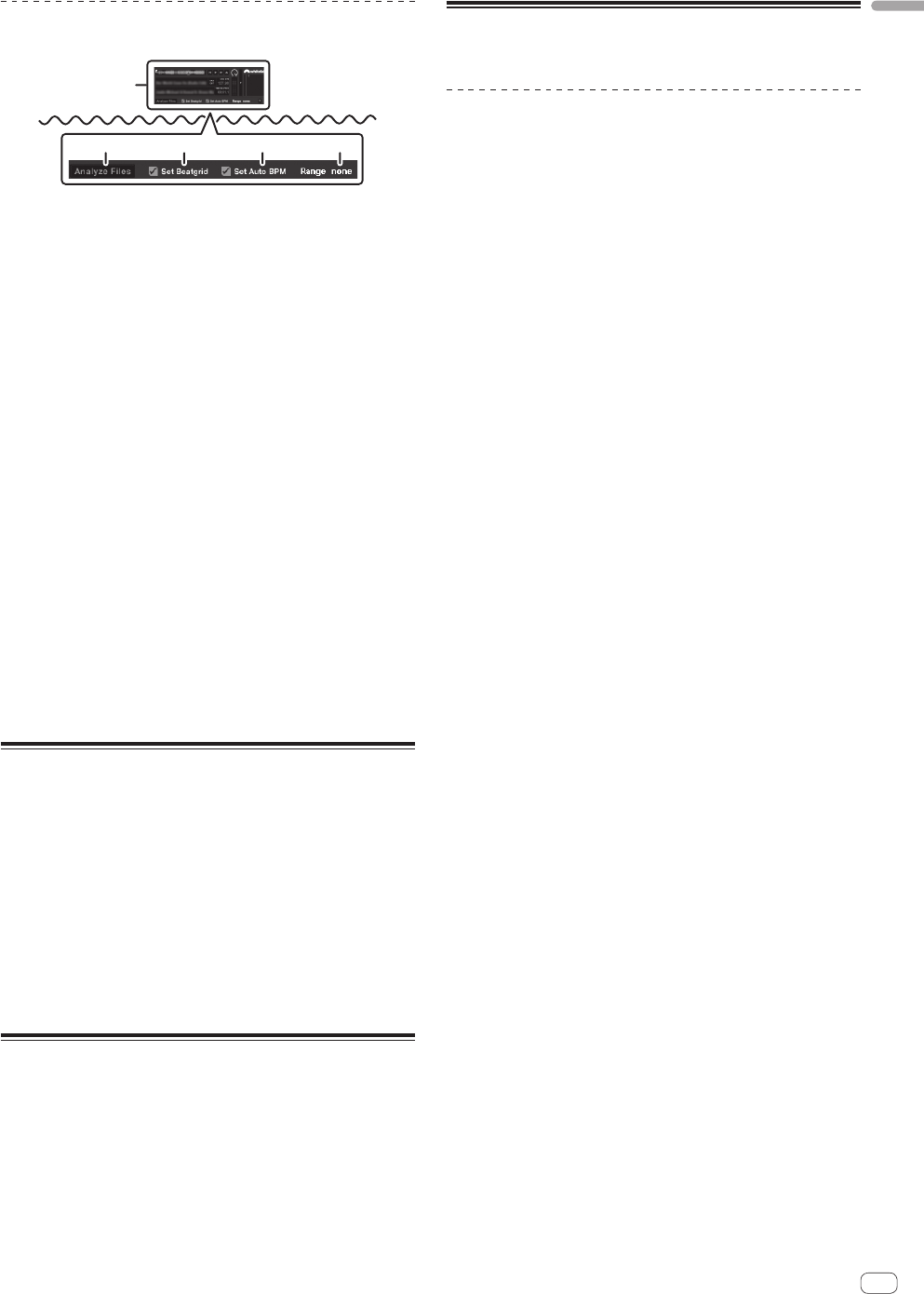
17
En
English
Screen when this unit is not connected
1
2
4
35
1 Offline player
The offline player is available when your ITCH hardware is not con-
nected and will output through the current default audio device. In
most cases, this will be from your computer speakers.
! Load a track to the offline player by dragging and dropping onto
the offline player or by pressing the computer’s [shift] key and
[c] key. If the end of the loaded track is reached, the next track
in the current playlist will automatically play next.
The offline player is a useful tool for preparing crates, auditioning
tracks, and setting cue and loop points.
! When [d] on the right side is clicked, the hidden part is dis-
played. The loops and hot cues can be set here.
2 ANALYZE FILES
Used to analyze tracks.
The analyze files function processes the tracks in your library to
detect file corruption, prepare the waveform overviews, and if
enabled calculate the BPM values.
3 Set Beatgrid
When [Set Beatgrid] is checked, the beat position is automatically
analyzed when analyzing the track and the beat grid is attributed
automatically.
4 Set auto bpm
When [Set auto bpm] is checked, the BPM is automatically ana-
lyzed when the track is analyzed.
5 range
Used to specify the BPM analysis range when [Set auto bpm] is
operating.
Starting the system
1 Turn on the connected microphone and external
equipment.
2 Connect the USB cable between this unit and the
computer.
3 Boot up the connected computer.
4 Slide the [ON/OFF] switch to the [ON] side.
5 After this unit’s indicators light, launch ITCH.
If the computer and this unit are linked properly, two virtual decks will
appear on the screen.
Quitting the system
1 Turn off the connected microphone and external
equipment.
2 Quit ITCH.
3 Slide the [ON/OFF] switch to the [OFF] side.
4 Disconnect the USB cable from your computer.
Operating the Library
Within the library, tracks can be imported and managed easily.
Adding music files to the library
! When adding music files stored on an external device to the library,
connect this device before launching ITCH.
! Tracks can also be added from an iTunes library.
To display the iTunes library, change the settings at the [SETUP]
menu.
For details on the settings, see Show iTunes Library on page 31.
! To add tracks recorded on discs to the library, first import the tracks
to the computer and convert them into a file type that can be played
with ITCH.
The playing performance may decrease if tracks recorded on discs
are played directly.
When converting tracks into music files, we recommend converting
them into MP3 format (320 kbps/MPEG-1 Audio Layer-3) for high
sound quality with a low CPU usage rate.
1 Press the [FILES] button.
The contents of your computer or the peripheral connected to the com-
puter are displayed in the [Files] panel.
2 Select the desired folder using the computer’s mouse.
With the computer’s mouse, click the folder containing the track you
want to add to the library in the [Files] panel.
3 Drag and drop the selected folder to the crate list
panel using the computer’s mouse.
! When a folder in which music files are stored is dragged and
dropped in the crate list panel, that folder becomes a crate
including all the tracks in it and the tracks are also added to the
library.
! There are several ways to add tracks to your ITCH library.
— When tracks that have not been added to the library are
loaded directly into a deck, they are automatically added to
[All...] on the crate list panel.
— Files and folders can also be added from Explorer or Finder by
dragging and dropping them to the track list or crate list on
the ITCH screen.
— To add the music file to the desired crates, drag and drop the
music file to the position at which you want to add it on the
ITCH screen.
— A track or group of tracks can be dragged on to the crate list
panel and a crate will be created containing these.
Playable music file formats
MP3, OGG (Vorbis format), AAC, ALAC (Apple Lossless), AIF, WAV and
WL.MP3 (Whitelabel.MP3)
About AAC files
! AAC is the abbreviation of “Advanced Audio Coding”, a basic format
of audio compression technology used for MPEG-2 and MPEG-4.
! The file format and extension of AAC data depends on the applica-
tion used to create the data.
! On this unit, in addition to AAC files with the extension “.m4a”
encoded with iTunes
®
, “.aac” and “.mp4” files can also be played.
However, copyright-protected AAC files purchased from the iTunes
Store, etc., cannot be played. Also, it may not be possible to play
certain files.
About WL.MP3
Whitelabel MP3 (file extension “.wl.mp3”), is a custom MP3 format
developed by Serato Audio Research for promotional release purposes
and can be acquired from Whitelabel.net. Files in Whitelabel MP3 format
are specifically for use with Serato Audio Research DJ software, have
preinstalled overviews, and the track, artist, BPM and album art data is
tagged as far as possible. These files are played with a low quality of 32
kbps on regular MP3 players (including when played independently on
ITCH software without using this unit), but with a high quality equivalent
to 320 kbps when played on ITCH software connected to this unit.





















